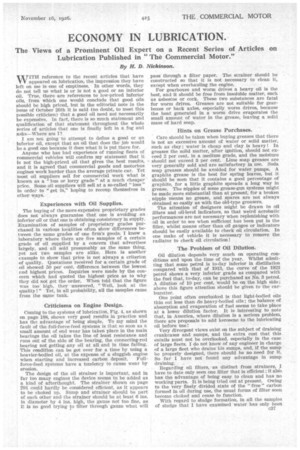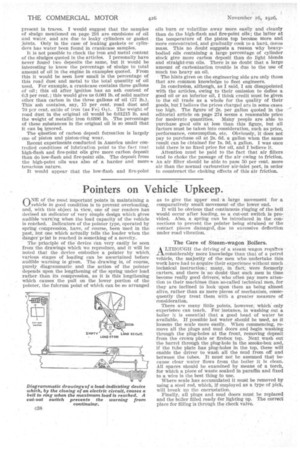ECONOMY IN LUBRICATION.
Page 59

Page 60

If you've noticed an error in this article please click here to report it so we can fix it.
The Views of a Prominent Oil Expert on a Recent Series of Articles on Lubrication Published in "The Commercial Motor."
By H. D. Nickinson.
V-N1TH reference to the recent articles that have appeared on lubrication, the impression they have left on me is one of emptiness. In other words, they do not tell us what is or is not a good or an inferior oil. True, there are references to low-priced inferior oils, from which one would conclude that good oils should be high priced, but in the editorial note in the issue of October 26th it is said (no doubt, to meet this possible criticism) that a good oil need not necessarily be expensive. In fact, there is so much statement and Qualification of that statement throughout the whole series of articles that one is finally left in a fog and asks—Where am I?
I am not going to attempt to define a good or an inferior oil, except that an oil that does the job would be a good one because it does what it is put there for.
Anyone who has had experience of running fleets of commercial vehicles will confirm my statement that it is not the high-priced oil that gives the best results, and it is agreed that commercial goods and motorbus engines work harder than the average private car. Yet most oil suppliers sell for commercial work what is known as a "bus or lorry grade" at a much cheaper price. Some oil suppliers will sell at a so-called "loss" in order to "get, in," hoping to recoup themselves in other ways.
Experiences with Oil Supplies.
The buying of the more expensive proprietary grades does not always guarantee that one is avoiding an inferior oil or that one is obtaining consistency in supply. Examination of samples of proprietary grades purchased in various localities often show differences between the same grades of one firm's goods. I know a laboratory where there are five samples of a certain grade of oil supplied by a concern that advertises largely, and all sold presumably as the same thing, yet not two samples are alike. Here is another example to show that price is not always a criterion of quality. Quotations received for a certain grade of oil showed 50 per cent, difference between the lowest end highest prices. Inquiries were made by the concern which had quoted the highest price as to why they did not get the order. When told that the figure was too' high, they answered, " Well, look at the quality !" Yet, in all probability, all the samples came from the same tank.
Criticisms on Engine Design.
Coming to the systems of lubrication, Fig. 4, as shown on page 188, shows very good results in practice and has the advantage of being simple. To my mind the fault of the full-force-feed systems is that so soon as a small amount of end wear has taken place in the main bearings the oil takes the line of least resistance and runs out of the side of the bearing, the connecting-rod bearing not getting any oil at all and in time failing. This condition can be got over for a time by using a heavier-bodied oil, at the expense of a sluggish engine
when starting and increased carbon deposit. Fullforce-feed systems have a tendency to cause wear by erosion.
The design of the oil strainer is important, and in far too many engines the device seems to be added as a kind of afterthought. The strainer shown on page 291 could hardly be considered efficient, as it appears to be choked up. Sump and strainer should be part of each other and the strainer should be at least 6 ins. in diameter by 4 ins, high, the gauze not too fine, as It is no good trying to filter through gauze what will pass through a filter paper. The strainer should be constructed so that it is not necessary to clean it, except when overhauling the engine.
For gearboxes and worm drives a heavy oil is the best, and it should be free from insoluble matter, such as asbestos or cork. These two substances are fatal for worm drives. Greases are not suitable for gearboxes or back axles, especially worm drives, because the heat generated in a worm drive evaporates the small amount of water in the grease, leaving a solid mass of hard soap.
Hints on Grease Purchases.
Care should be taken when buying greases that there is not an excessive amount of water or solid matter, such as clay; water is cheap and clay is heavy ! In greases the solid matter, after ignition, should not exceed 2 per cent, in a medium grade, and the moisture should not exceed 3 per cent. Lime soap greases are very generally sold and are satisfactory in use. Soda soap greases should be avoided for water pumps. A graphite grease is the best for spring leaves, but it should be seen that it contains a good percentage of graphite, for a little graphite spreads a long way in grease. The nipples of some grease-gun systems might be made more substantial than at present, for a broken nipple means no grease, and spares are not always obtained so easily as with the old-type greasers.
The attention of designers might be drawn to oil fillers and oil-level indicators, so that weird acrobatic performances are not necessary when replenishing with oil in order to see when sufficient has been put in the filler, whilst means other than oil gauges or indicators should be easily available to check oil circulation. In one make of vehicle it is necessary to remove the radiator to check oil circulation!
The Problem of Oil Dilution.
Oil dilution depends very much on operating conditions and upon the time of the year. Whilst admitting that some petrol is to-day inferior in distillation compared with that of 1913, the curve of the 1923 petrol shows a very inferior grade as compared with the fuel that, to-day, can be purchased as No. 3 petrol. A dilution of 10 per cent. would be on the high side; above this figure attention should be given to the carburetter.
One point often overlooked is that fight-bodied oils thin out less than do heavy-bodied oils ; the balance of absorption and evaporation of fuel seems to take place at a lower dilution factor. It is interesting to note that, in America, where dilution is a serious problem, there are proposals to add kerosene to the lubricating oil before use!
Very divergent views exist on the subject of draining crankcases and sumps, and the extra cost that this entails must not be overlooked, especially in the case of large fleets. I do not know of any engineer in charge of a large fleet who drains his sumps, and, if the sump be properly designed, there should be no need for it. So far I have not found any advantage in sump draining. _ Regarding oil filters, as distinct from strainers, I have to date only seen one filter that is efficient ; it also has the advantage of being easy to clean and has no working parts. It is being tried out at present. Owing to the very finely divided state of the "free" carbon formed in oil during use, the usual forms of filter soon become choked and cease to function.
With regard to sludge formation, in all the samples of sludge that I have examined water has only been present in traces. I would suggest that the samples of sludge mentioned on page 291 are emulsions of oil and water, and are due to leaky cylinders or gasket joints. Only in the case of leaking gaskets or cylinders has water been found in crankcase samples.
It is not possible to check the iron and metal content of the sludges quoted in the artieles. I personally have never found two deposits the same, but it would be interesting to know the percentage of sludge to total amount of oil in the engine in examples quoted. From this it would be seen how small is the percentage of this road dust and metal to the total quantity of oil used. For example, a crankcase contains three gallons of oil ; this oil after ignition has an ash content of 0.3 per cent. ; this would give us 0.081 lb. of solid matter other than carbon in the three gallons of oil (27 lb). This ash contains, say, 15 per cent. road dust and 70 per cent. oxide of iron (as Ire.; 0-1). The weight of road dust in the original oil would be 0.01215 lb. and the weight of metallic iron 0.0396 lb. _ The percentage of these substances in the original oil is so small that it can 4 ignored.
The question of carbon deposit formation is largely one of piston and piston-ring wear.
Recent experiments conducted in America under controlled conditions of lubrication point to the fact trio high-flash and fire-point oils give more carbon deposit than do low-flash and fire-point oils. The deposit from the high-point oils was also of a harder and more tenacious nature.
It would appear that the low-flash and fire-point
oils burn or volatilize away more easily and cleanly than do the high-flash and fire-point oils; the latter at the temperature of the piston top become more and more concentrated, and gradually cook to a hard, dense mass. This no doubt suggests a reason why heavybodied oils containing a large percentage of cylinder stock give more carbon deposit than do light blends and straight-run oils. There is no doubt that a large amount of carbonization trouble is due to the use of much too heavy an oil.
The hints given on the engineering side are only those that are common knowledge to fleet engineers.
In conclusion, although, as I said, I am disappointed with the articles, owing to their omission to define a good oil or an inferior oil, I think credit must be given to the oil trade as a whole for the quality of their goods, but I believe the prices charged are in some cases too high. The figure of 2s. per gallon quoted in the editorial article on page 274 seems a reasonable price for moderate quantities. Many people are able to purchase good oils at less than this figure, but all factors must be taken into consideration, such as price, performance, consumption, etc. Obviously, it does not pay to purchase oil at 2s. 13d. a gallon when the same result can be cbtained for is. 9d. a gallon. I was once told there is no fixed price for on, and I believe it.
Attention must be paid to the fact that air filters tend to choke the passage of the air owing to friction.
• An air filter should be able to pass 50 per cent, more air than the normal carburetter air-inlet port, in order to counteract the choking effects of this air friction.












































































































